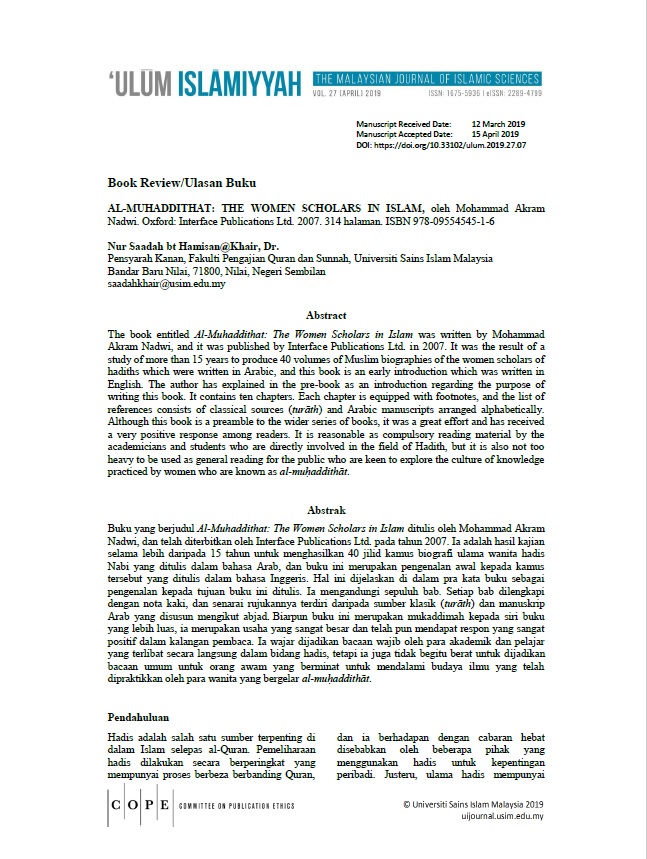Al-Muhaddithat: The Women Scholars In Islam
by Mohammad Akram Nadwi
DOI:
https://doi.org/10.33102/uij.vol27no1.109Keywords:
Book review, Al-Muhaddithat, Mohamad Akran Nadwi, Women in Islam, Islam, ThoughtAbstract
The book entitled Al-Muhaddithat: The Women Scholars in Islam was written by Mohammad Akram Nadwi, and it was published by Interface Publications Ltd. in 2007. It was the result of a study of more than 15 years to produce 40 volumes of Muslim biographies of the women scholars of hadiths which were written in Arabic, and this book is an early introduction which was written in English. The author has explained in the pre-book as an introduction regarding the purpose of writing this book. It contains ten chapters. Each chapter is equipped with footnotes, and the list of references consists of classical sources (turāth) and Arabic manuscripts arranged alphabetically. Although this book is a preamble to the wider series of books, it was a great effort and has received a very positive response among readers. It is reasonable as compulsory reading material by the academicians and students who are directly involved in the field of Hadith, but it is also not too heavy to be used as general reading for the public who are keen to explore the culture of knowledge practiced by women who are known as al-muḥaddithāt.
Abstrak
Buku yang berjudul Al-Muhaddithat: The Women Scholars in Islam aditulis oleh Mohammad Akram Nadwi, dan telah diterbitkan oleh Interface Publications Ltd. pada tahun 2007. Ia adalah hasil kajian selama lebih daripada 15 tahun untuk menghasilkan 40 jilid kamus biografi ulama wanita hadis Nabi yang ditulis dalam bahasa Arab, dan buku ini merupakan pengenalan awal kepada kamus tersebut yang ditulis dalam bahasa Inggeris. Hal ini dijelaskan di dalam pra kata buku sebagai pengenalan kepada tujuan buku ini ditulis. Ia mengandungi sepuluh bab. Dimulai dengan “Pendahuluan” sebelum bab pertama, dan diakhiri dengan “Rujukan” dan “Indeks”. Setiap bab dilengkapi dengan nota kaki, dan senarai rujukannya terdiri daripada sumber klasik (turāth) dan manuskrip Arab yang disusun mengikut abjad. Biarpun buku ini merupakan mukaddimah kepada siri buku yang lebih luas, ia merupakan usaha yang sangat besar dan telah pun mendapat respon yang sangat positif dalam kalangan pembaca. Ia wajar dijadikan bacaan wajib oleh para akademik dan pelajar yang terlibat secara langsung dalam bidang hadis, tetapi ia juga tidak begitu berat untuk dijadikan bacaan umum untuk orang awam yang berminat untuk mendalami budaya ilmu yang telah dipraktikkan oleh para wanita yang bergelar al-muḥaddithāt.
Downloads
References
Berkey, Jonathan P. (1992). Women and Education in the Mamluk Period. Women in Middle Eastern History: Shifting Boundaries in Sex and Gender. New Haven: Yale University Press.
Goldziher, Ignaz. (1977). Women in the Hadith Literature. Muslim Studies. Vol.2, 366-368.
Kabbani, M. H., & Bakhtiar, L. (1998). Encyclopedia of Muhammad’s Women Companions and the Traditions They Related. Chicago: ABC International Group.
Roded, Ruth. (1994). Women in Islamic Biographical Collections: From Ibn Sa’d to Who's Who. Colorado & London: Lynne Rienner Publishers.
Sayeed, Asma. (2005). Shifting Fortunes Women and Ḥadith Transmission in Islamic History (First to Eighth Centuries). Princeton University.
Siddiqi, M. Z. (1993). Women Scholars of Hadith. In Hadith Literature: Its Origin, Development, Special Feature & Criticism. Cambridge: The Islamic Texts Society.
The Royal Islamic Strategic Studies Centre. (2018). The 10th Anniversary Edition, The World’s 500 Most Influential Muslims, 2019. Amman, Jordan: The Royal Islamic Strategic Studies Centre.

Downloads
Published
How to Cite
Issue
Section
License
If the article is accepted for publication, the copyright of this article will be vested to author(s) and granted the journal right of first publication with the work simultaneously licensed under the Creative Commons Attribution-NonCommercial 4.0 International License, unless otherwise stated. Anyone may reproduce, distribute, translate and create derivative works of this article (for both commercial and non-commercial purposes), subject to full attribution to the original publication and authors. The full terms of this licence may be seen at https://creativecommons.org/licenses/by-nc/4.0/.






